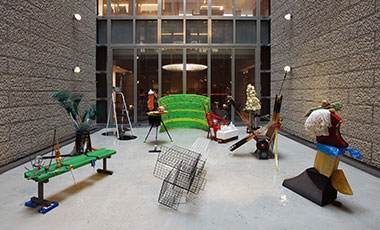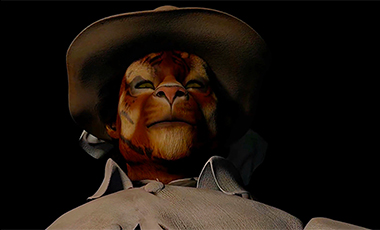This past September, the eyes and ears of the Korean art world were on the nominee exhibitions and award ceremonies for the country’s top two art award events, the Korea Artist Prize and the Hermès Foundation Missulsang. Important occasions for the local art community, they are considered two of the biggest events on the calendar. This piece takes a look back at how those events have developed, sharing expert onions on just what the 2013 exhibition means -- and what questions they raise.
Contemporary Artists Become More Transparent
 At the entrance of the 2013 Korea Artist Prize gallery_MMCA, Gwacheon
At the entrance of the 2013 Korea Artist Prize gallery_MMCA, Gwacheon
The Korea Artist Prize has changed since the last year's event trying to show their will to remain the contemporary art open to the public. Until the last year, the recommendations and reviews took place behind closed doors. However, starting this year, the nominee decisions were based on recommendations from ten outside experts, with an exhibition staged for all the nominees to prove their mettle before the final decision. Someone will eventually be crowned as the winner, but the hope is that sharing the process with the public can ensure some objectivity. Showing the whole process like this definitely makes them harder on the organizers, but it meets one of the conditions for awards to function as they’re supposed to: drawing popular attention. The best part of the new selection method is that it allows for a real-time comparison of the artists’ work, the sum total of their capabilities. It’s a chance to cast aside the biased information and prejudices that even the major decision-markers bring to the table -- never mind the gallery-going public -- and look at the candidates’ pieces with a clean slate. Over the years, the prevailing paradigms and discourses of the art world haven’t been too concerned with what should be their primary point of reference, the fruits of the artist’s intensive labors. They’ve been dogged by popular phenomena like prejudice, bandwagon-ism, and battles of wills. This kind of arbitrariness, which shouldn’t be confused with “freedom,” has been enabled by an apathetic public. What should be the critic’s most fundamental job -- objective analysis of specific artist products -- seems like it is being left for the art historians of the distant future. Is there no rational way of approaching objectivity in the here and now where the art is actually being produced and shared?
 Exhibition for Kong Sung-hun, 2013 Korea Artist Prize winner
Exhibition for Kong Sung-hun, 2013 Korea Artist Prize winner
Objectivity is the most important obligation for art institutions and discourse should contain. Art is obviously a field where the subjective takes precedence over the objective, feeling over reason. The problem is that this “subjectivity” and “feeling” carries with it too much arbitrary throwing around of weight. Clearly, the objectivity issue isn’t going to be taken care of automatically just because outside committee members did the recommendations this time, or because two foreign art world figures are taking part in the final judging. But in the gallery, there is a common thread running through the work of the four nominees: The weight of its truth and realism has shifted to the outside. This is a good thing, certainly much better than those dreary arts awards and their overweening self-conscious desire to create something utterly unheard-of. Instead of an insular world that begins and ends fully subjective, this is something transparent, neutral, which paradoxically has the effect of highlighting the work and its idiosyncrasy.
This neutral transparency is not about the routine and banal, or the scientific and dry. It’s about meeting the conditions -- the window shouldn’t be blurred by the artist’s presence; the perfume maker and scent sniffer should be odorless. The modern artists we witness with the Korea Artist Prize are evolving into invisible (wo)men. The media are eclectic, with videos, objects, painting, and sculpture, but there’s an interest in the society, history, and nature that the artists belong to, a stubborn and meticulous approach to possessing a world that is stranger and more diverse than art, that exists before the self. These visions were free from the schematic, from fathomless and endless sentiment.
The hall for Ham Yang-ah, set up like a theater screening the artist’s visions, suggests a factory where different worlds are produced. Spread out in various composition planes, these are worlds where different forms of logic and method exist in a single, colorless pixel, free from even the slightest accent. Thus displayed, they are folded up for the next world to be witnessed. It is remarkable to notice the otherside of the everyday, captured and presented analytically with anatomical precision. Sliding away from nature and forming its own kingdom, the human society begins to resemble nature once again. There are no rational goals prescribed by society, no projections of the future ahead. The productive principles that set each world in motion are filled with blindness and unreason, yet this is neither tragedy nor comedy. Their mere existence is a marvel; the art cuts across the society where the screens are hung, becoming an important means of investigating those worlds. The small desk next to this odds-and-ends store is the seat for the lonely explorer.
Jo Hae-jun more or less completely forsakes the training and polished grammar he acquired as a contemporary artist. He commands a diverse range of media, from videos to objects, but all are unembellished. This return to simplicity shouldn’t necessarily be viewed as a departure from modern art conventions; that approach, after all, origination from a communion with the primeval other. In work where words and speech are crucial, the returned other drives a narrative that has been suppressed in art. This is not the “picture journal,” endlessly laying out subjects that are presumed to constitute centers of meaning. Mixed into it are different perspective and tiny voices from the artist’s circle, including his father. These are not monophonic monologues, but polyphonic dialogues. The frames, finished in wood, present themselves as windows onto the world.
 L) Jo Hae-jun_Commemorative Tree_2003-2013_100+ pieces, mixed materials, drawing, three dimensional, installation_300x400x400cm
L) Jo Hae-jun_Commemorative Tree_2003-2013_100+ pieces, mixed materials, drawing, three dimensional, installation_300x400x400cmR) Jo Hae-jun_North Joseon, Landscape Reflected Outside North Korea_2011_Pencil on paper, wood, acrylic_120x290x40cm
 Ham Yang-ah_Bird’s View_2008_Three-channel video installation
Ham Yang-ah_Bird’s View_2008_Three-channel video installation
For Shin Mee-kyoung, the world is reduced to a museum of the imagination. Anything in the world can be the subject of art, with the art that results forming a microcosm that reflects its macrocosm in form and content. Shin sees the word through the window of art, and the world finds definitive expression through art. The artist takes creations from every region and place and material, and translates them into soap sculptures. Though translation can never be fully transparent, it does at least have transparency as its aim. Shin’s translation -- rewriting different symbolic universes in soap -- is less about the creator’s ambitions than her acceptance of the role of re-creator. It’s been said that there is nothing new under the sun, and art history bears this out. But when the translation process involves placing artist within the cycles of a greater space and time, change is inevitable. Different cultures, arts, and subjectivities have been formed through this very transformation. Seemingly eternal and unchanging, these prototypes and archetypes are as changeable as soft soap.
Kong Sung-hun has used many different media in his career, but since the late 1990s, he has viewed painting as the most advanced, “high-tech” medium, one that allows him to sustain and expand the density and intensity of his work. It’s a bold, even reckless step back coming from a perspective where the body, the repository of all human perception, memory, and movement, is thoroughly domesticated and managed through encoding. Self-Portrait (2001), painted around the time of Kong’s “conversion,” shows what looks like an emperor who is entranced to his art only while the city Rome is on fire. Later on, the artist would turn to the value-neutrality of nature as a setting for society and history. From this stage of incidents large and small, he gently slips away, becoming not a subject but a mere prism viewing the world analytically. The naturalist precision expands the surface of the world to limitless dimensions, inside of which human stories are tucked away. Nature in Kong’s work is not free from the circuits of desire, but with the primitive power it emanates, something that can never be encoded or colonialized, he illustrates a universal context into which history and art should be placed.
 L) Shin Mee-kyoung_Translation Venus Project_2002(restored 2013)_Soap_200x90x90cm
L) Shin Mee-kyoung_Translation Venus Project_2002(restored 2013)_Soap_200x90x90cmR) Shin Mee-kyoung_Translation Series Exhibition
 L) Kong Sung-hun_Gray Hair_2013_Oil on canvas_227.3x181.8cm
L) Kong Sung-hun_Gray Hair_2013_Oil on canvas_227.3x181.8cmR) Kong Sung-hun_Man Smoking a Cigarette (Cliff)_2013_Oil on canvas_227.3x181.8cm
Photos © National Museum of Modern and Contemporary Art, Korea

Lee Sun-young / Art Critic
Lee Sun-young began her criticism career in the Chosun Ilbo’s art criticism category in 1994. She has served as an editorial board member for Art and Discourse (1996--2006) and editor-in-chief for Art Critics (2003--05). She also sat on the committee for the Art in City project (2006--07) and was an advisor for the Incheon Foundation for Arts and Culture’s local community cultural creation program (2012--13). The Awards include the 1st annual Kim Bok-jin Art Theory Award (2005) and the first annual Korean Art Critics’ Association Award for theory (2009).


